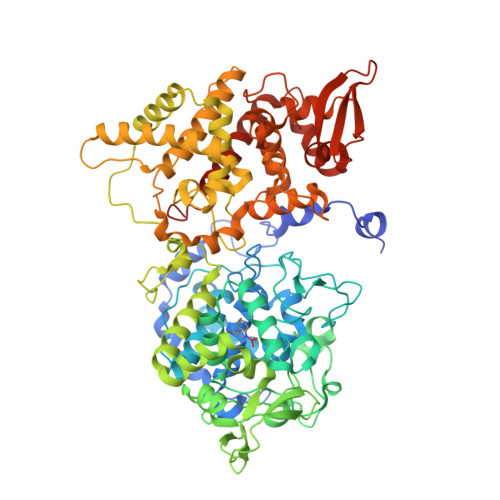The Catalase Activity of Catalase-Peroxidases Is Modulated by Changes in the pKa of the Distal Histidine.
Machuqueiro, M., Victor, B., Switala, J., Villanueva, J., Rovira, C., Fita, I., Loewen, P.C.(2017) Biochemistry 56: 2271-2281
- PubMed: 28409923
- DOI: https://doi.org/10.1021/acs.biochem.6b01276
- Primary Citation of Related Structures:
5KQ0, 5KQ2, 5KQ3, 5KQ6, 5KQH, 5KQI, 5KQK, 5KSF, 5KSK, 5SYU, 5SYV, 5SYW, 5TXQ, 5V4O, 5V53 - PubMed Abstract:
The unusual Met-Tyr-Trp adduct composed of cross-linked side chains along with an associated mobile Arg is essential for catalase activity in catalase-peroxidases. In addition, acidic residues in the entrance channel, in particular an Asp and a Glu ∼7 and ∼15 Å, respectively, from the heme, significantly enhance catalase activity. The mechanism by which these channel carboxylates influence catalase activity is the focus of this work. Seventeen new variants with fewer and additional acidic residues have been constructed and characterized structurally and for enzymatic activity, revealing that their effect on activity is roughly inversely proportional to their distance from the heme and adduct, suggesting that the electrostatic potential of the heme cavity may be affected. A discrete group of protonable residues are contained within a 15 Å sphere surrounding the heme iron, and a computational analysis reveals that the pK a of the distal His 112 , alone, is modulated within the pH range of catalase activity by the remote acidic residues in a pattern consistent with its protonated form having a key role in the catalase reaction cycle. The electrostatic potential also impacts the catalatic reaction through its influence on the charged status of the Met-Tyr-Trp adduct.
Organizational Affiliation:
Centro de Química e Bioquímica, Departamento de Química e Bioquímica, Faculdade de Ciências, Universidade de Lisboa , 1749-016 Lisboa, Portugal.





















